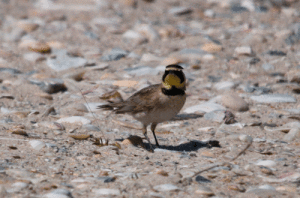
Horned Lark observed feeding in the dunes along Matagorda Peninsula. Photo taken by Taylor Bennett on March, 3rd, 2022.
We at Gulf Coast Bird Observatory are surveying for non-breeding shorebirds along Matagorda Beach, Bryan Beach, Quintana Beach, Surfside Beach, and Follet’s Island. After one more month of this, we will begin surveying for beach nesting birds. Our target species are Piping Plover, Snowy Plover, Red Knot, Black Skimmer, and American Oystercatcher. Along with these species, we often come across other bird species as well. This past week while surveying on Matagorda Beach, we spotted a couple of Horned Lark feeding along the beach.
Shorebirds are not the only ones that utilize the beach for food and shelter. Small songbirds like Horned Lark are typically observed year-round here on the shores of Upper Texas Coast. They can also be found in prairies and heavily grazed pastures. We mainly observe them feeding on seeds and insects along the dunes of Matagorda Peninsula.
There are over 40 subspecies of Horned Lark based on their plumage and size. The subspecies that we observe here is Eremophila alpestris giraudi. It is classified as being slightly smaller and having a browner back and a pale-yellow throat compared to the other subspecies. They have a lightly spotted white-yellowish belly, black collar, black legs, and small black bill. Their head is bright yellow with an eyebrow stripe and broad black stripes along the eyes making it appear to have a mustache when looking directly towards you. Their namesake comes from feather tufts that stick out like horns from their heads, though that feature only appears on the males during the breeding season. They breed along the Texas coast from mid-February to mid-July.
Like the Wilson’s Plover, they are also ground nesters and nest along the dunes near vegetation. In the Horned Lark world, the female does all the work with little to no help from her male counterpart. She picks the site, builds the nest, incubates the eggs, and takes care of the chicks. The male does help with feeding, but that’s about it.
The female either finds a natural depression in the sand or makes one herself using her bill and feet. She then collects pebbles, clods, corncobs, etc. and places them on the excavated area. These pavings are believed to prevent the material of the nest from blowing away. She then weaves a nest out of grass or other plant materials and lines the nest with down, feathers, fur, etc.
Horned Larks can lay two to five camouflaged eggs per brood and can have one to three broods a year. The female incubates the nest up to 12 days. Even though they are ground nesters, the chicks are born blind and covered in down like typical songbirds. It takes up to 4 days for them to gain sight and they are able to leave the nest around 12 days. At that point, they are able to move around and feed on small insects; however, mom and dad still take care of them until they are ready to fly at 27 days of age.
As with all birds on the beach, please be cautious and give the Horned Larks plenty of space. Please also keep dogs on leash and keep the beaches cleaner than you found them. On behalf of Gulf Coast Bird Observatory, thanks for reading.
